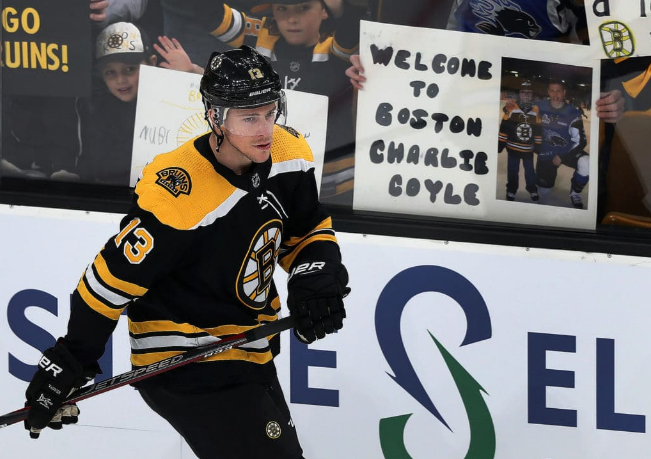
( Photo Credit: USA TODAY Sports )
The forward depth and secondary scoring were issues that the Boston Bruins needed to address between the start of the season and the playoffs. While the play of the team itself had certainly improved prior to the trade deadline, the Bruins’ recent acquisitions put them over the top.
Fans who scoffed at the names Charlie Coyle and Marcus Johansson because neither was pursued heavily by cup contenders are frustrating at best. These fans also have likely never watched either player at length to effectively assess what it is they bring to the table.
I could go for days on how Dirty Don swindled the entire league by flying under the radar to stealthily scoop up two of the most attractive forward options at the deadline. Charlie Coyle brings a puck possessing, playmaking grittiness to the Bruins’ middle 6. Marcus Johansson brings a smooth skating, puck-possessing, playmaking style of hockey to the Bruins’ middle 6.

( Photo Credit: The Athletic )
Hey, look at that! Our middle 6 just got twice as good. What were those issues we were talking about earlier? Forward depth and secondary scoring? Smell ya later.
Power Play Bonus
But what goes unnoticed with these two is just how deadly they’ll make the already prolific Bruins’ powerplay, which currently sits at 3rd in the league in efficiency.
He’s yet to be rewarded, but Charlie Coyle is already giving Bruins’ bottom-6 a major facelifthttps://t.co/j17iELmL2q
— Conor Ryan (@ConorRyan_93) March 4, 2019
https://platform.twitter.com/widgets.js
Charlie Coyle is a smooth skating big body who makes plays and has a silky set of mitts. Marcus Johansson is a proven playmaker who was raised on the power play. I’ve heard several reports that his first word was “sauce.” Put a big body like Coyle in front of the net or in the slot (catch ya later, Backes), or let him make plays from the half wall. Tell Johansson to post up on the goal line and have fun. I mean the guy’s name is MoJo—I’m pretty sure he knows how to thread the needle through a few triangles.
What was your favorite #NJDevils Marcus Johansson pass to Kyle Palmieri on the 5-on-3 in the 1st period. Was it …
The diagonal give-and-go? pic.twitter.com/YJfdwDToCW
— Corey Masisak (@cmasisak22) February 2, 2019
https://platform.twitter.com/widgets.js
Is it shocking that two proven power play contributors will get time on the powerplay? Absolutely not. But what the rest of the league might not be ready for is the depth that Coyle and Johansson bring to the Bruins’ second unit. Until recently, the B’s have essentially utilized their first powerplay unit. Not exclusively, but it wasn’t unlikely to see Torey Krug’s unit on the ice for more than a minute and a half of a 2-minute peeper.
Granted, the unit had proven to still be effective when tired or when deep into a powerplay. But the additional minutes that the first PP unit has played due to the once massive drop off in efficiency between the two units certainly has the potential to creep in during crunch time. If you’re fuzzy on this phenomenon, maybe watch the game film of the Bruins’ last few overtime games. Holy flatness.
Now that there’s a second unit that can wheel and deal, expect the Bruins’ to continue dummy PK units that are forced to share the same ice surface. Two effective units mean shorter, more fast-paced shifts that will wear down opposing defensemen and penalty killers while keeping the Bruins’ top dogs fresh for later in the game when the bench shortens.
That’s just about as simple and abbreviated as anyone could make the positive effects that Coyle and Johansson have on the Bruins’ lineup.
But I’m a simple man.


Leave a Reply